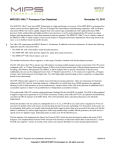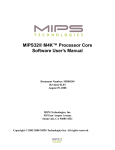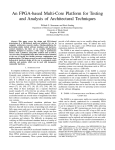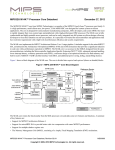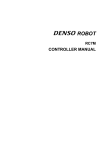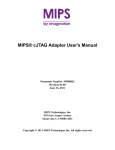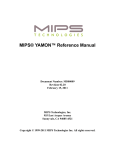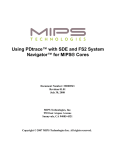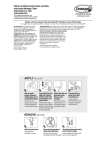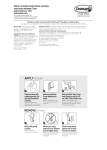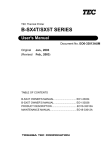Download Verified™
Transcript
MIPS
Verified
interAptiv™ Multiprocessing System Datasheet
™
September 20, 2012
The interAptiv™ multiprocessing system is a high performance device containing between 1 and 4 coherent processors with
best-in-class power efficiency for use in system-on-chip (SoC) applications. The interAptiv architecture combines a multithreading pipeline with a highly intelligent coherence manager to deliver best in class computational throughput and power
efficiency. The interAptiv core is fully configurable/synthesizable and can contain one to four MIPS32® interAptiv CPU cores,
system-level coherence manager with L2 cache, optional coherent I/O port, and optional floating point unit.
The interAptiv multiprocessing system is available in the following configurations. All of these configurations include a second generation Coherence Manager with integrated L2 cache (CM2).
• Dual-core, configurable as either 1 or 2 cores
• Quad-core, configurable as 1, 2, 3, or 4 cores
The MIPS32 interAptiv multiprocessing system contains the following logic blocks.
• interAptiv Cores (1 - 4)
• Cluster Power Controller (CPC)
• Coherence Manager (2nd generation) with integrated L2 cache (CM2)
• One or Two I/O Coherence Units (IOCU)
• Optional multi-threaded Floating Point Unit (FPU)
• Global Interrupt Controller (GIC)
• Global Configuration Registers (GCR)
• Coherent Processing System (CPS) Debug Unit
• Optional PDTrace in-system trace debugger
Figure 1 interAptiv Multiprocessing System Level Block Diagram
Cluster Power Controller
interAptiv
CPU 1
Interv
Port
interAptiv
CPU 2
.
interAptiv
CPU 4
Global
Interrupt
Controller
Config
Registers
Debug
Control
Req
Port
Coherence Manager with Integrated L2 Cache Controller
I/O
Coherence
Unit
L2 Cache Memory
OCP 2.1
Coherent I/O
Devices
OCP 2.1
Optional
Main Memory
Non-Coherent I/O
Debug
PDTrace
In the interAptiv multiprocessing system, multi-CPU coherence is handled in hardware by the Coherence Manager. The
optional I/O Coherence Unit (IOCU) supports hardware I/O coherence by bridging a non-coherent OCP I/O interconnect to the
CM2 and handling ordering requirements. The Global Interrupt Controller (GIC) handles the distribution of interrupts between
interAptiv™ Multiprocessing System Datasheet, Revision 01.01
Copyright © 2012 MIPS Technologies Inc. All rights reserved.
MD00903
and among the CPUs. Under software controlled power
management, the Cluster Power Controller (CPC) can gate
off the clocks and/or voltage supply to idle cores.
Features
CPU core-level features:
• 8/9-stage pipeline with integer, floating point and
optional CorExtend execution units shared amongst issue
pipes
• Optional IEEE-754 compliant multi-threaded Floating
Point Unit (FPU)
System-level features:
• 1- 4 coherent MIPS32® interAptiv CPU cores
• Second generation system-wide Coherence Manager
(CM2) providing L2 cache, I/O and interrupt coherence
across all CPU cores.
• Integrated 8-way set associative L2 cache controller
supporting 0 KB to 8 MB cache sizes with variable wait
state control for 1:1 clock and optimal SRAM speed
• Supports cache to cache data transfers
• Speculative memory reads and Out-of-order data return
to reduce latency
• User-defined global configuration registers
• Hardware I/O coherence port (optional) with up to 2
IOCU’s per system
• SOC system interface bus supports OCP version 2.1
protocol with 32-bit address and 64-bit or 256-bit data
paths
• Enhanced virtual addressing (EVA) mode allows for up
to 3.0 GB of user or kernel virtual address space
• Integrated integer Multiply/Divide Unit (MDU)
• Programmable Memory Management Unit
– L1 Cache sizes of 4/8/16/32/64 KB, 4-Way Set
Associative
– 16/32/48/64 dual-entry JTLB per VPE
– 8-entry DTLB
– 4 - 12 entry ITLB
– L1 MESI coherent cache states
– 32-byte cache line size
– 64-bit data an 32-bit address paths to caches
– Virtually indexed, physically tagged
– Parity or ECC support on L1 Dcache and DSPRAM
– Parity support on L1 Icache and ISPRAM
– Supports up to 1MB of instruction and data
Scratchpad RAM (optional)
• MIPS32 Release3 Instruction Set and Privileged
Resource Architecture
• Power Control
– Minimum frequency: 0 MHz
– Software controlled power-down mode (triggered by
WAIT instruction)
– Software-controlled clock divider
– Cluster-level dynamic clocking
– Cluster Power Controller (CPC) controlling shut
down of idle CPU cores
• Core Power Reduction Features
– Power reduction by turning off core clock during
outstanding bus requests
– Power reduction by implementing intelligent way
selection in the L1 instruction cache
– Power Reduction by enabling 32-bit accesses of the
L1 data cache RAMs
• EJTAG Debug 5.0 port supporting multi-CPU debug,
System-level trace and performance analysis.
• MIPS PDtrace debug version 6 (optional)
• MIPS16e™ Code Compression (optional)
• MIPS MT Application Specific Extension (ASE)
– Support for 1 or 2 Virtual Processing Elements
(VPEs) each with 1 Thread Context (TC)
– Inter-Thread Communication (ITC) memory for
efficient communication & data transfer
– Supports 1 - 9 thread contexts depending on the
number of cores
• MIPS DSP Application Specific Extension (ASE)
– 3 additional pairs of accumulator registers
– Fractional data types, Saturating arithmetic
– SIMD instructions operate on 2x16b or 4x8b
simultaneously
• CorExtend® MIPS32 compatible User Defined
Instruction Set Extensions allows user to define and add
instructions to the core at build time
– PC, data address and data value tracing w/ trace
compression
– Includes features for correlation with CM trace
– Support for on-chip and off-chip trace memory
2
interAptiv™ Multiprocessing System Datasheet, Revision 01.01
Copyright © 2012 MIPS Technologies Inc. All rights reserved.
interAptiv™ CPU Core
Figure 2
interAptiv™ CPU Core Block Diagram
OCP Interface
On-Chip Buses
Bus Interface Unit
Instruction
Cache
Program
Counters (1-9)
(4-64 KB 4-way)
Instruction
Fetch Unit
Instruction
Scratchpad RAM
ISPRAM
Interface
(4KB – 1MB)
TC
Instruction
Buffers (1-9)
Memory
Management
Units (x2)
Thread
Scheduler
Unit
4-12 Entry
ITLB
Decoder
8 Entry
DTLB
16-64 Dual Entry JTLB
Memory Pipe
CorExtend™
CorExtend
Interface
CoProcessor
Floating
Point Unit
ALU
Load Store
Address
Inter-Thread
Communications
Unit
EJTAG
Trace
Data
Cache
TAP
(4-64 KB 4-way)
Data
Scratchpad
Off/Onchip
Trace I/F
Optional
Ram
Debug
Off-chip
Interface
The figure above shows a block diagram of a single
interAptiv core. The following subsections describe the logic
blocks in this diagram. For more information on the
interAptiv core in a multiprocessing environment, refer to the
debug mode section.
MIPS Release 3 Architecture
In addition to the base architecture, the interAptiv core
supports the MIPS MT ASE that defines multi-threaded
operation, the MIPS16e™ ASE for code compression, and
the MIPS DSP ASE for accelerating integer SIMD codes.
(4 KB – 1 MB)
DSPRAM
Interface
MIPS Multi-Thread Technology
Building on the prior generation of MIPS multi-threaded
(MT) processors, the interAptiv core also implements the
same multi-threaded architecture and supports the
Application Specific Extensions (MT ASE) which are based
on a two-layered framework involving Virtual Processing
Elements (VPEs) and Thread Contexts (TCs). Each
interAptiv core can support up to two VPEs which share a
single pipeline among other hardware resources. However,
since each VPE includes a complete copy of the processor
state as seen by the software system, each VPE appears as a
complete standalone processor to an SMP Linux operating
interAptiv™ Multiprocessing System Datasheet, Revision 01.01
Copyright © 2012 MIPS Technologies Inc. All rights reserved.
3
system. For more fine-grained thread processing
applications, each VPE is capable of supporting multiple
TCs. The TCs share a common execution unit but each has its
own program counter and core register files so that each can
handle a thread from the software. The interAptiv core can
support up to nine TCs allocated across two VPEs, optimized
and partitioned at run time. Figure 3 shows the relationship
of the OS, VPEs, TCs, and the common hardware in the
interAptiv core.
In order to fetch instructions without intervention from the
execution unit, the fetch unit contains branch prediction
logic. A 512-entry Branch History Table (BHT) is used to
predict the direction of branch instructions, a 4-entry Return
Prediction Stack (RPS) holds the return address from the
most recent subroutine calls. The link address is pushed onto
the stack whenever a JAL, JALR, or BGEZAL instruction is
seen. The address is popped when a JR instruction occurs.
Thread Schedule Unit (TSU)
Figure 3 Single interAptiv Core with VPE’s
Process 1
Process 2
Operating System
VPE0
VPE1
TC0
TCn
Common Hardware
(Fetch, Decode, Execution Unit, Caches)
Single interAptiv Core with multiple VPEs
In addition to supporting the MT ASE, the core also supports
the MIPS16e™ ASE for code compression, and the MIPS
DSP ASE for accelerating integer SIMD codes.
This unit is responsible for dispatching instructions from
different Thread Contexts (TCs), a policy manager assigns
priorities for each TC. The TSU determines which TCs are
available and selects the highest priority one available. If
multiple TCs are available, a round-robin mechanism will
select between them.
Policy Manager
The policy manager is a configurable block. Simple roundrobin or fixed priority policies can be selected during design.
interAptiv includes a reference policy manager that
implements a weighted round-robin algorithm for long-term
distribution of execution bandwidth.
Execution Unit
The interAptiv CPU execution unit implements a load/store
architecture with single-cycle ALU operations (logical, shift,
add, subtract) and an autonomous multiply/divide unit. Each
TC on a interAptiv CPU contains thirty-one 32-bit generalpurpose registers used for integer operations and address
calculation. Additional sets of shadow register files can be
added to be dedicated for interrupt and exception processing.
The register file consists of two read ports and one write port
and is fully bypassed to minimize operation latency in the
pipeline.
The execution unit includes:
• 32-bit adder used for calculating the data address
• Logic for verifying branch prediction
Instruction Fetch Unit
• Load aligner
This block is responsible for fetching instructions for all
Thread Contexts (TCs). Each TC has an 8-entry instruction
buffer (IBF) that decouples the fetch unit from the execution
unit. When executing instructions from multiple TCs, a
portion of the IBF is used as a skid buffer. Instructions are
held in the IBF after being sent to the execution unit. This
allows stalled instructions to be flushed from the execution
pipeline without needing to be fetched again.
• Bypass multiplexers used to avoid stalls when executing
instructions streams where data producing instructions
are followed closely by consumers of their results
• Leading Zero/One detect unit for implementing the CLZ
and CLO instructions
• Arithmetic Logic Unit (ALU) for performing bit-wise
logical operations
• Shifter and Store Aligner
4
interAptiv™ Multiprocessing System Datasheet, Revision 01.01
Copyright © 2012 MIPS Technologies Inc. All rights reserved.
MIPS16e™ Application Specific Extension
The interAptiv CPU includes support for the MIPS16e ASE.
This ASE improves code density through the use of 16-bit
encoding of many MIPS32 instructions plus some MIPS16especific instructions. PC relative loads allow quick access to
constants. Save/Restore macro instructions provide for single
instruction stack frame setup/tear-down for efficient
subroutine entry/exit.
Multiply/Divide Unit (MDU)
The multiply/divide unit (MDU) contains a separate pipeline
for integer multiply and divide operations. This pipeline
operates in parallel with the integer unit pipeline.
The MDU consists of a pipelined 32x32 multiplier, result/
accumulation registers (HI and LO), a divide state machine,
and the necessary multiplexers and control logic.
The MDU supports execution of one multiply or multiply
accumulate operation every clock cycle whereas divides can
be executed as fast as one every six cycles.
Floating Point Unit (FPU)
The optional Floating Point Unit (FPU) implements the
MIPS64 ISA (Instruction Set Architecture) for floating-point
computation. The FPU contains thirty-two 64-bit registers
used for floating point operations. The implementation
supports the ANSI/IEEE Standard 754 (IEEE Standard for
Binary Floating-Point Arithmetic) for single and double
precision data formats.
The FPU can be configured at build time to run at either the
same or one-half the clock rate of the integer CPU. The FPU
is not as deeply pipelined as the integer CPU so the maximum
CPU frequency will only be attained with the FPU running at
one-half the CPU frequency.
FPU Performance
FPU performance is optimized for single precision formats.
Most instructions have one FPU cycle throughput. The FPU
implements the MIPS64 multiply-add (MADD) and
multiply-sub (MSUB) instructions with intermediate
rounding after the multiply function. The result is guaranteed
to be the same as executing a MUL and an ADD instruction
separately, but the instruction latency, instruction fetch,
dispatch bandwidth, and the total number of register accesses
are greatly improved.
flush-to-zero mode is provided to optimize performance. The
fast flush-to-zero mode is enabled through the FCCR register,
and use of this mode is recommended for best performance
when denormalized results are generated.
The FPU has a separate pipeline for floating point instruction
execution. This pipeline operates in parallel with the integer
pipeline. This allows long-running FPU operations, such as
divide or square root, to be partially masked by system stalls
and/or other integer unit instructions. Arithmetic instructions
are dispatched and completed in order, loads and stores can
complete out of order.
The FPU implements a bypass mechanism that allows the
result of an operation to be forwarded directly to the
instruction that needs it without having to write the result to
the FPU register and then read it back.
System Control Coprocessor (CP0)
In the MIPS architecture, CP0 is responsible for the virtualto-physical address translation and cache protocols, the
exception control system, the processor’s diagnostic
capability, the operating modes (kernel, user, supervisor, and
debug), and whether interrupts are enabled or disabled.
Configuration information, such as cache size and
associativity, presence of features like MIPS16e or floating
point unit, is also available by accessing the CP0 registers.
Coprocessor 0 also contains the logic for identifying and
managing exceptions. Exceptions can be caused by a variety
of sources, including boundary cases in data, external events,
or program errors.
Most of CP0 is replicated per VPE. A small amount of state
is replicated per TC and some is shared between the VPEs.
Interrupt Handling
Each interAptiv VPE includes support for six hardware
interrupt pins, two software interrupts, a timer interrupt, and
a performance counter interrupt. These interrupts can be used
in the following interrupt modes:
• Interrupt compatibility mode, which acts identically to
that in an implementation of Release 1 of the
Architecture.
• Vectored Interrupt (VI) mode, which adds the ability to
prioritize and vector interrupts to a handler dedicated to
that interrupt, and to assign a GPR shadow set for use
during interrupt processing. The presence of this mode is
denoted by the VInt bit in the Config3 register. This mode
IEEE denormalized input operands and results are supported
by hardware for some instructions. IEEE denormalized
results are not supported by hardware in general, but a fast
interAptiv™ Multiprocessing System Datasheet, Revision 01.01
Copyright © 2012 MIPS Technologies Inc. All rights reserved.
5
is architecturally optional; but it is always present on the
interAptiv CPU, so the VInt bit will always read as a 1
for the interAptiv CPU.
• If a TC is configured to be used as a shadow register set,
the VI interrupt mode can specify which shadow set
should be used upon entry to a particular vector. The
shadow registers further improve interrupt latency by
avoiding the need to save context when invoking an
interrupt handler.
Figure 4 shows how the ITLB, DTLB, and JTLB are
implemented in the interAptiv CPU.
Figure 4 interAptiv Core Address Translation
Virtual Address
Instruction Address
Calculator
IVA
Instruction TLB
IVA
Modes of Operation
Comparator
Instruction
Hit/Miss
Comparator
Data
Hit/Miss
Entry
JTLB
The interAptiv CPU supports four modes of operation: user
mode, supervisor mode, kernel mode, and debug mode. User
mode is most often used for application programs. Supervisor
mode gives an intermediate privilege level with access to the
ksseg address space. Supervisor mode is not supported with
the fixed mapping MMU. Kernel mode is typically used for
handling exceptions and operating system kernel functions,
including CP0 management and I/O device accesses. An
additional Debug mode is used during system bring-up and
software development. Refer to "EJTAG Debug Support" on
page 15 for more information on debug mode.
Memory Management Unit (MMU)
Each interAptiv VPE contains a Memory Management Unit
(MMU) that is primarily responsible for converting virtual
addresses to physical addresses and providing attribute
information for different segments of memory. In a dual-TLB
configuration, each VPE contains a separate JTLB so that
translations for each VPE are independent from the other
VPE.
Translation Lookaside Buffer (TLB)
The basic TLB functionality is specified by the MIPS32
Privileged Resource Architecture. A TLB provides mapping
and protection capability with per-page granularity. The
interAptiv implementation allows a wide range of page sizes
to be simultaneously present.
The TLB contains a fully associative Joint TLB (JTLB). To
enable higher clock speeds, two smaller micro-TLBs are also
implemented: the Instruction Micro TLB (ITLB) and the
Data Micro TLB (DTLB). When an instruction or data
address is calculated, the virtual address is compared to the
contents of the appropriate micro TLB (uTLB). If the address
is not found in the uTLB, the JTLB is accessed. If the entry is
found in the JTLB, that entry is then written into the uTLB. If
the address is not found in the JTLB, a TLB exception is
taken.
6
Instruction
Cache Tag RAM
Entry
DVA
Data Address
Calculator
DVA
Data TLB
Virtual Address
Data
Cache Tag RAM
Joint TLB (JTLB)
The JTLB is a fully associative TLB cache containing 16, 32,
48, or 64-dual-entries mapping up to 128 virtual pages to their
corresponding physical addresses. The address translation is
performed by comparing the upper bits of the virtual address
(along with the ASID) against each of the entries in the tag
portion of the joint TLB structure.
The JTLB is organized as pairs of even and odd entries
containing pages that range in size from 4 KB to 256 MB, in
factors of four, into the 4 GB physical address space. The
JTLB is organized in page pairs to minimize the overall size.
Each tag entry corresponds to two data entries: an even page
entry and an odd page entry. The highest order virtual address
bit not participating in the tag comparison is used to
determine which of the data entries is used. Since page size
can vary on a page-pair basis, the determination of which
address bits participate in the comparison and which bit is
used to make the even-odd determination is decided
dynamically during the TLB look-up.
Instruction TLB (ITLB)
The ITLB contains between 4 and 12 entries and is dedicated
to performing translations for the instruction stream. The
ITLB is a hybrid structure having 3 entries that are shared by
all TCs plus an additional entry dedicated to each TC.
Therefore, a single core system with one VPE and one TC
would have a 4-entry TLB with all entries dedicated to one
core. Conversely, a single core system with 1 VPE and 9 TC’s
would have a three shared entries, plus one entry per TC, for
a total of 12 entries.
interAptiv™ Multiprocessing System Datasheet, Revision 01.01
Copyright © 2012 MIPS Technologies Inc. All rights reserved.
The ITLB maps 4 KB or 1 MB pages/subpages. For 4 KB or
1 MB pages, the entire page is mapped in the ITLB. If the
main TLB page size is between 4 KB and 1 MB, only the
current 4 KB subpage is mapped. Similarly, for page sizes
larger than 1 MB, the current 1 MB subpage is mapped.
Figure 5 Enhanced Virtual Addres
Kernel Virtual
Address
4.0 GB
User Virtual
Address
Physical Memory
4.0 GB
4.0 GB
3.0 GB
3.0 GB
Kernel Mapped
(kseg3)
3.5 GB
The ITLB is managed by hardware and is transparent to
software. The larger JTLB is used as a backing structure for
the ITLB. If a fetch address cannot be translated by the ITLB,
the JTLB is used to translate it.
Kernel Mapped
(kseg)
3.0 GB
Kernel
Un-Mapped
(xkseg0)
Data TLB (DTLB)
The DTLB is an 8-entry, fully associative TLB dedicated to
performing translations for loads and stores. All entries are
shared by all TCs. Similar to the ITLB, the DTLB maps either
4 KB or 1 MB pages/subpages.
The DTLB is managed by hardware and is transparent to
software. The larger JTLB is used as a backing structure for
the DTLB. If a load/store address cannot be translated by the
DTLB, a lookup is done in the JTLB. The JTLB translation
information is copied into the DTLB for future use.
Enhanced Virtual Address
The interAptiv core contains a programmable memory
segmentation scheme called Enhanced Virtual Address
(EVA), which allows for more efficient use of 32-bit address
space. Traditional MIPS virtual memory support divides up
the virtual address space into fixed segments, each with fixed
attributes and access privileges. Such a scheme limits the
amount of physical memory available to 0.5GB, the size of
kernel segment 0 (kseg0).
In EVA, the size of virtual address space segments can be
programmed, as can their attributes and privilege access.
With this ability to overlap access modes, kseg0 can now be
extended up to 3.0GB, leaving at least one 1.0GB segment for
mapped kernel accesses. This extended kseg0 is called
xkseg0. This space overlaps with useg, because segments in
xkseg0 are programmed to support mapped user accesses and
unmapped kernel accesses. Consequently, user space is equal
to the size of xkseg0, which can be up to 3.0GB. This concept
is shown in Figure 5.
0.0 GB
User Mapped
(useg)
Main Memory
0.0 GB
0.0 GB
Figure 5 shows an example of how the traditional MIPS
kernel virtual address space can be remapped using
programmable memory segmentation to facilitate an
extended virtual address space. As a result of defining the
larger kernel segment as xkseg0, the kernel has unmapped
access to the lower 3GB of the virtual address space. This
allows for a total of 3GB of DRAM to be supported in the
system.
To allow for efficient kernel access to user space, new load
and store instructions have been defined which allow kernel
mapped access to useg.
Note that the attributes of xkseg0 are the same as the previous
kseg0 space in that it is a kernel unmapped, uncached region.
Level 1 Data Cache
The Level 1 (L1) data cache is an on-chip memory block of
4/8/16/32/64 KB, with 4-way associativity. A tag entry holds
22 bits of physical address, two cache state bits, and an
optional parity bit. The data entry holds 64 bits of data per
way, with optional parity or ECC per byte. There are 4 data
entries for each tag entry. The tag and data entries exist for
each way of the cache. The way-select array holds the dirty
and LRU replacement algorithm bits for all 4 ways (6-bit
LRU, 4-bit dirty, and optionally 4-bit dirty parity or 12 bits of
ECC).
Virtual aliasing can occur when using 4KB pages in the TLB
and 32 or 64KB cache sizes. Because it is quite challenging
for software to manage virtual aliases across multiple
devices, these larger cache arrays are banked on the aliased 1
or 2 physical address bits to eliminate the virtual aliases.
interAptiv™ Multiprocessing System Datasheet, Revision 01.01
Copyright © 2012 MIPS Technologies Inc. All rights reserved.
7
The interAptiv CPU supports data-cache locking. Cache
locking allows critical code or data segments to be locked
into the cache on a “per-line” basis, enabling the system
programmer to maximize the efficiency of the system cache.
The locked contents can be updated on a store hit, but are not
selected for replacement on a cache miss. Locked lines do not
participate in the coherence scheme so processes which lock
lines into a particular cache should be locked to that processor
and prevented from migrating.
The cache-locking function is always available on all datacache entries. Entries can then be marked as locked or
unlocked on a per entry basis using the CACHE instruction.
The data cache supports ECC dual-bit error detection and
single-bit error correction.
Level 1 Instruction Cache
The Level 1 (L1) instruction cache is an on-chip memory
block of 4/8/16/32/64 KB, with 4-way associativity. A tag
entry holds 22 bits of physical address, a valid bit, a lock bit,
and an optional parity bit. The instruction data entry holds
two instructions (64 bits), 6 bits of pre-decode information to
speed the decode of branch and jump instructions, and 9
optional parity bits (one per data byte plus one more for the
pre-decode information). The instruction cache does not
support ECC. There are four data entries for each tag entry.
The tag and data entries exist for each way of the cache. The
LRU replacement bits (6-bit) are shared among the 4 ways
and are stored in a separate array.
The instruction cache block also contains and manages the
instruction line fill buffer. Besides accumulating data to be
written to the cache, instruction fetches that reference data in
the line fill buffer are serviced either by a bypass of that data,
or data coming from the external interface. The instruction
cache control logic controls the bypass function.
The interAptiv CPU supports instruction-cache locking.
Cache locking allows critical code or data segments to be
locked into the cache on a “per-line” basis, enabling the
system programmer to maximize the efficiency of the system
cache.
The cache-locking function is always available on all
instruction-cache entries. Entries can then be marked as
locked or unlocked on a per entry basis using the CACHE
instruction.
Level 1 Cache Memory Configuration
The interAptiv CPU incorporates on-chip L1 instruction and
data caches that are typically implemented from readily
available single-port synchronous SRAMs and accessed in
two cycles: one cycle for the actual SRAM read and another
cycle for the tag comparison, hit determination, and way
selection. The instruction and data caches each have their
own 64-bit data paths and can be accessed simultaneously.
Table 1 lists the interAptiv CPU instruction and data cache
attributes.
Table 1
interAptiv™ CPU L1 Instruction and Data
Cache Attributes
Parameter
Instruction
Data
Size1
4, 8, 16, 32,
or 64 KB
4, 8, 16, 32,
or 64 KB
Organization
4 way set
associative
4 way set
associative
Line Size
32 Bytes
32 Bytes
Read Unit
64 bits
64 bits
Write Policies
N/A
coherent and noncoherent writeback with write
allocate
Miss restart after
transfer of
miss word
miss word
Cache Locking
per line
per line
1. For Linux based applications, MIPS recommends a 64 KB L1
cache size, with a minimum size of 32 KB.
Instruction and Data Scratchpad RAM
The interAptiv core allows blocks of scratchpad RAM to be
attached to the load/store and/or instruction units. These
allow low-latency access to a fixed block of memory. The
size of both the instruction scratch pad RAM (ISPRAM) and
data scratch pad RAM (DSPRAM) can be configured from a
range of 4 KB to 1 MB. These RAM’s are used for the
temporary storage of information and can be modified by the
user at any time. The ISPRAM supports ECC error detection/
correction and parity bit.
InterThread Communication Unit (ITU)
This block provides a mechanism for efficient
communication between TCs. This block has a number of
locations that can be used as mailboxes, FIFO mailboxes,
mutexes, and semaphores.
8
interAptiv™ Multiprocessing System Datasheet, Revision 01.01
Copyright © 2012 MIPS Technologies Inc. All rights reserved.
Bus Interface (BIU)
Interrupt Handling
The Bus Interface Unit (BIU) controls a 64-bit interface to the
CM2. The interface implements the industry standard “Open
Core Protocol” (OCP) interface.
The interAptiv core supports six hardware interrupts, two
software interrupts, a timer interrupt, and a performance
counter interrupt. These interrupts can be used in any of three
interrupt modes.
Write Buffer
The BIU contains a merging write buffer. The purpose of this
buffer is to store and combine write transactions before
issuing them to the external interface. The write buffer is
organized as eight, 32-byte buffers. Each buffer can contain
data from a single 32-byte aligned block of memory. When
using the write-through cache policy or performing uncached
accelerated writes, the write buffer significantly reduces the
number of write transactions on the external interface and
reduces the amount of stalling in the core caused by the
issuance of multiple writes in a short period of time.
The write buffer also holds eviction data for write-back lines.
The load-store unit extracts dirty data from the cache and
sends it to the BIU. In the BIU, the dirty data is gathered in
the write buffer and sent out as a bursted write.
For uncached accelerated references, the write buffer can
gather multiple writes together and then perform a bursted
write to increase the efficiency of the bus. Uncached
accelerated gathering is supported for word or dword stores.
• Interrupt compatibility mode, which acts identically to
that in an implementation of Release 1 of the
Architecture.
• Vectored Interrupt (VI) mode, which adds the ability to
prioritize and vector interrupts to a handler dedicated to
that interrupt. The presence of this mode is denoted by
the VInt bit in the Config3 register. This mode is
architecturally optional. As it is always present on the
interAptiv core, the VInt bit will always read 1.
• External Interrupt Controller (EIC) mode, which provides
support for an external interrupt controller that handles
prioritization and vectoring of interrupts. This mode is
optional in the Release 2 architecture. The presence of
this mode is denoted by the VEIC bit in the Config3
register.
Modes of Operation
The interAptiv core supports four modes of operation:
User mode, most often used for application programs.
Gathering of uncached accelerated stores can start on any
arbitrary address and can be combined in any order within a
cache line. Uncached accelerated stores that do not meet the
conditions required to start gathering are treated like regular
uncached stores.
SimpleBE Mode
To aid in attaching the interAptiv core to structures that
cannot easily handle arbitrary byte-enable patterns, there is a
mode that generates only “simple” byte enables. In this mode,
only byte enables representing naturally aligned byte,
halfword, word, and doubleword transactions will be
generated.
In SimpleBE mode, the SI_SimpleBE input pin only controls
the byte enables generated by the interAptiv core(s). It has no
effect on byte enables produced by the IOCU. To achieve the
effect of setting SI_SimpleBE to ‘one’ in systems with an
IOCU, the I/O sub-system must only issue requests to the
IOCU with naturally aligned byte enables.
When the SI_SimpleBE input signal to the interAptiv core is
asserted, hardware sets bit 21 of the config register
(Config.SB) to indicate the device is in simple byte enable
mode.
• Supervisor mode provides an intermediate privilege level
with access to the ksseg (kernel supervisor segment)
address space.
• Kernel mode, typically used for handling exceptions and
operating system kernel functions, including CP0
management and I/O device accesses.
• Debug mode is used during system bring-up and software
development. Refer to Section 2.17 “EJTAG Debug
Support” for more information on debug mode.
Multiprocessing System
The interAptiv Multiprocessing System (MPS) consists of the
logic modules shown on page 1. Each of these blocks is
described throughout this section.
Cluster Power Controller (CPC)
Individual CPUs within the cluster can have their clock and/
or power gated off when they are not in use. This gating is
managed by the Cluster Power Controller (CPC). The CPC
handles the power shutdown and ramp-up of all CPUs in the
cluster. Any interAptiv CPU that supports power-gating
features is managed by the CPC.
interAptiv™ Multiprocessing System Datasheet, Revision 01.01
Copyright © 2012 MIPS Technologies Inc. All rights reserved.
9
Intervention Unit (IVU)
The CPC also organizes power-cycling of the CM2
dependent on the individual core status and shut-down policy.
Reset and root-level clock gating of individual CPUs are
considered part of this sequencing.
The Intervention Unit (IVU) interrogates the L1 caches by
placing requests on the intervention OCP interfaces. Each
processor responds with the state of the corresponding cache
line. For most transactions, if a CPU core has the line in the
MODIFIED or EXCLUSIVE states, it provides the data with
its response. If the original request was a read, the IVU routes
the data to the original requestor via the Response Unit
(RSU). For the MESI protocol, intervention data may also be
routed to the L2/Memory via the TRU (implicit writeback).
Coherence Manager (CM2)
The Coherence Manager with integrated L2 cache (CM2) is
responsible for establishing the global ordering of requests
and for collecting the intervention responses and sending the
correct data back to the requester. A high-level view of the
request/response flow through the CM2 is shown in Figure 6.
Each of the blocks is described in more detail in the following
subsections.
Request Unit (RQU)
The Request Unit (RQU) receives OCP bus transactions from
multiple CPU cores and/or I/O ports, serializes the
transactions and routes them to the Intervention Unit (IVU),
Transaction Routing Unit (TRU), or an auxiliary port used to
access a configuration registers or memory-mapped IO. The
routing is based on the transaction type, the transaction
address, and the CM2’s programmable address map.
Figure 6
Coherence Manager with Integrated L2 Cache (CM2) Block Diagram
Intervention
Request Ports
Main Request Ports
Intervention
Response Ports
Main Response Ports
....
....
Coherent
Request Unit
Auxiliary
Ports
Intervention Unit
Non-Coherent & Speculative Coherent
Performance
Counters
Global Configuration
Registers
L1 Hits
Response Unit
L1 Hits/Non-Speculative
Coherent
Transaction Routing Unit
Cached
Misses/UnCached
Reads
Un-Cached/L2 Bypass
Hits
PDTrace
L2 Cache
EJTAG TAP
To IOCU
& MMIO
Refills
System Memory Unit
Misses/
Evictions
To GIC
& CPC
256-bit Memory
Request
Port
Optional
10
256-bit Memory
Response
Port
interAptiv™ Multiprocessing System Datasheet, Revision 01.01
Copyright © 2012 MIPS Technologies Inc. All rights reserved.
The IVU gathers the responses from each of the agents and
manages the following actions:
• Speculative reads are resolved (confirmed or cancelled).
• Memory reads that are required because they were not
speculative are issued to the Memory Interface Unit
(MIU).
• Modified data returned from the CPU is sent to the MIU
to be written back to memory.
• Data returned from the CPU is forwarded to the
Response Unit (RSU) to be sent to the requester.
• The MESI state in which the line is installed by the
requesting CPU is determined (the “install state”). If
there are no other CPUs with the data, a Shared request is
upgraded to Exclusive.
Each device updates its cache state for the intervention and
responds when the state transition has completed. The
previous state of the line is indicated in the response. If a read
type intervention hits on a line that the CPU has in a Modified
or Exclusive state, the CPU returns the cache line with its
response. A cacheless device, such as the IOCU, does not
require an intervention port. Note that the IVU is not included
in non-coherent configurations, such as a single core without
an IOCU.
When a coherent read receives an intervention hit in the
MODIFIED or EXCLUSIVE state, the Intervention Unit
(IVU) provides the data to the RSU. The RSU then returns the
data to the requesting core.
Transaction Routing Unit
The Transaction Routing Unit (TRU) arbitrates between
requests from the RQU and IVU, and routes requests to either
the L2 or the SMU. The TRU also contains the request and
intervention data buffers which are written directly from the
RQU and IVU, respectively. The TRU reads the appropriate
write buffer when it processes the corresponding write
request.
Level 2 Cache
The unified Level 2 (L2) cache holds both instruction and
data references and contains a 7-stage pipeline to achieve
high frequencies with low power while using commercially
available SRAM generators.
Cache read misses are non-blocking; that is, the L2 can
continue to process cache accesses while up to 15 misses are
outstanding. The cache is physically indexed and physical
tagged. shows a block diagram of the L2 cache.
Figure 7 L2 Cache Block Diagram
The System Memory Unit (SMU) provides the interface to
the memory OCP port. For an L2 refill, the SMU reads the
data from an internal buffer and issues the refill request to the
L2 pipeline.
Note that the external interface may operate at a lower
frequency than the Coherence Manager (CM2), and the
external block may not be able to accept as many requests as
multiple CPUs can generate, so some buffering of requests
may be required.
Transaction
Routing Unit
Cache Memory Controller
SRAM Timing Controller
System Memory Unit (SMU)
L2 Cache RAM
256 Kbyte – 8 Mbyte
System Memory Interface
Response Unit (RSU)
The RSU takes responses from the SMU, L2, IVU, or
auxiliary port and places them on the appropriate OCP
interface. Data from the L2 or SMU is buffered inside a buffer
associated with each RSU port, which is an enhancement
over the previous generation Coherence Manager.
256-bit Memory
Request
Port
256-bit Memory
Response
Port
L2 Cache Configuration
The L2 cache in the CM2 can be configured as follows:
interAptiv™ Multiprocessing System Datasheet, Revision 01.01
Copyright © 2012 MIPS Technologies Inc. All rights reserved.
11
• 0, 128, 256, 512, 1024, 2048, 4096, or 8192 KBytes
• 32- or 64-byte line size
PDTrace Unit
The CM2 PDTrace Unit (PDT) is an optional unit used to
collect, pack and send out CM2 debug information.
• 8 ways
• 512 to 16384 sets per way (in powers of two)
Performance Counter Unit
L2 Pipeline Tasks
The L2 pipeline manages the flow of data to and from the L2
cache. The L2 pipeline performs the following tasks:
• Accesses the tags and data RAMs located in the memory
block (MEM).
The CM Performance Counter Unit (PERF) implements the
performance counter logic.
Coherence Manager Performance
The CM2 has a number of high performance features:
• Returns data to the RSU for cache hits.
• 64-bit wide internal data paths throughout the CM2
• Issues L2 miss requests.
• 64- or 256-bit wide system OCP interface
• Issues L2 write and eviction requests.
• Cache to Cache transfers: If a read request hits in another
L1 cache in the EXCLUSIVE or MODIFIED state, it will
return the data to the CM and it will be forwarded to the
requesting CPU, thus reducing latency on the miss.
• Returns L2 write data to the SMU. The SMU issues refill
requests to the L2 for installation of data for L2
allocations
L2 Cache Features
• Supports write-back operation.
• Pseudo-LRU replacement algorithm
• Programmable wait state generator to accommodate a
wide variety of SRAMs.
• Operates at same clock frequency as CPU.
• Speculative Reads: Coherent read requests are forwarded
to the memory interface before they are looked up in the
other caches. This is speculating that the cache line will
not be found in another CPU’s L1 cache. If another cache
was able to provide the data, the memory request is not
needed, and the CM2 cancels the speculative
request—dropping the request if it has not been issued, or
dropping the memory response if it has.
• Cache line locking support
• Optional ECC support for resilience to soft errors
I/O Coherence Unit (IOCU)
• Single bit error correction and 2 bit error detection
support for Tag and Data arrays
Optional support for hardware I/O coherence is provided by
the I/O Coherence Unit (IOCU), which maintains I/O
coherence of the caches in all coherent CPUs in the cluster.
Up to 2 IOCUs are supported in an interAptiv MPS.
• Single bit detection only for WS array
• Bypass mode
• Fully static design: minimum frequency is 0MHz
• Sleep mode
• Support for extensive use of fine-grained clock gating
• Optional memory BIST for internal SRAM arrays, with
support for integrated (March C+, IFA-13) or custom
BIST controller
The IOCU acts as an interface block between the Coherence
Manager 2 (CM2) and coherent I/O devices. Coherent reads
and writes of I/O devices generate interventions in other
coherent CPUs that query the L1 cache. I/O reads access the
latest data in caches or in memory, and I/O writes invalidate
stale cache data and merge newer write data with existing
data as required. An example system topology is shown in
Figure 8.
CM2 Configuration Registers
The Registers block (GCR) contains the control and status
registers for the CM2. It also contains the Trace Funnel,
EJTAG TAP state machine, and other multi-core features.
12
interAptiv™ Multiprocessing System Datasheet, Revision 01.01
Copyright © 2012 MIPS Technologies Inc. All rights reserved.
Figure 8
Role of a Single IOCU in a Two-Core Multiprocessing System
interAptiv
Coherent
Processing
System
Cluster Power Controller
interAptiv
CPU 1
interAptiv
CPU 2
Global
Interrupt
Controller
Config
Registers
Debug
Control
I/O
Interv
Port
I/O
I/O
Req
Port
Coherent Read
from I/O
Coherence Manager with Integrated L2 Cache
L2 Cache Memory
Read from I/O
I/O
Coherence
Unit
Write from
CPU
I/O Interconnect
Write to I/O
OCP 2.1
Optional
Main Memory
Non-Coherent I/O
The IOCU also provides a legacy (without coherent
extensions) OCP slave interface to the I/O interconnect for I/
O devices to read and write system memory. The reference
design also includes an OCP Master port to the I/O
interconnect that allows the CPUs to access registers and
memory on the I/O devices.
The reference IOCU design provides several features for
easier integration:
• A user-defined mapping unit can define cache attributes
for each request—coherent or not, cacheable (in L2) or
not, and L2 allocation policy.
• Supports incremental bursts up to 16 beats (128 bits) on
I/O side. These requests are split into cache-line- sized
requests on the CM side.
• Ensures proper ordering of responses for the split
requests and tagged requests.
In addition, the IOCU contains the following features used to
enforce transaction ordering.
• Set-aside buffer: This buffer can delay read responses
from the I/O device until previous writes have
completed.
• Writes are issued to the CM in the order they were
received.
– Coherent write is acknowledged after intervention
complete on all CPUs
• The IOCU can be configured to treat incoming writes as
non-posted and provide a write ACK when they become
visible.
Software I/O Coherence
For cases where system redesign to accommodate hardware
I/O coherence is not feasible, the CPUs and Coherence
Manager provide support for an efficient software-managed
I/O coherence. This support is through the globalization of
hit-type CACHE instructions.
When a coherent address is used for the CACHE operations,
the CPU makes a corresponding coherent request. The CM2
sends interventions for the request to all of the CPUs,
allowing all of the L1 caches to be maintained together. The
basic software coherence routines developed for single CPU
systems can be reused with minimal modifications.
Global Interrupt Controller
The Global Interrupt Controller (GIC) handles the
distribution of interrupts between and among the CPUs in the
cluster. This block has the following features:
• The CM provides an acknowledge (ACK) signal to the
IOCU when writes are "visible" (guaranteed that a
subsequent CPU read will receive that data).
– Non-coherent write is acknowledged after
serialization
interAptiv™ Multiprocessing System Datasheet, Revision 01.01
Copyright © 2012 MIPS Technologies Inc. All rights reserved.
13
• Software interface through can be relocated throughout
the memory-mapped address range.
• Configurable number of system interrupts - from 8 to 256
in multiples of 8.
• Support for different interrupt types:
– Level-sensitive: active high or low.
– Edge-sensitive: positive, negative, or double-edgesensitive.
• Ability to mask and control routing of interrupts to a
particular CPU.
At a warm start reset, the CPC brings all power domains into
their cold start configuration. However, to ensure power
integrity for all domains, the CPC ensures that domain
isolation is raised before power is gated off. Domains that
were previously powered and are configured to power up at
cold start remain powered and go through a reset sequence.
Within a warm start reset, sideband signals are also used to
qualify if coherence manager status registers and GIC watch
dog timers are to be reset or remain unchanged. The CPC,
after power up of any CPU, provides a test logic reset
sequence per domain to initialize TAP and PDTrace logic.
• Support for NMI routing.
• Standardized mechanism for sending inter-processor
interrupts.
Global Configuration Registers (GCR)
The Global Configuration Registers (GCR) are a set of
memory-mapped registers that are used to configure and
control various aspects of the Coherence Manager and the
coherence scheme.
Reset Control
The reset input of the system resets the Cluster Power
Controller (CPC). Reset sideband signals are required to
qualify a reset as system cold, or warm start. Register setting
determine the course of action:
• Remain in powered-down
• Go into clock-off mode
• Power-up and start execution
This prevents random power up of power domains before the
CPC is properly initialized. In case of a system cold start,
after reset is released, the CPC powers up the interAptiv
CPUs as directed in the CPC cold start configuration. If at
least one CPU has been chosen to be powered up on system
cold start, the CM2 is also powered up.
When supply rail conditions of power gated CPUs have
reached a nominal level, the CPC will enable clocks and
schedule reset sequences for those CPUs and the coherence
manager.
14
Note that unused CPUs are not held in reset until released by
writing into the configuration registers. Rather, unused CPUs
remain powered down and are held isolated towards the rest
of the cluster. If power gating is not selected for a given
implementation, unused CPUs are powered but receive no
clock and remain isolated until activated by the CPC.
In addition to controlling the deassertion of the CPC reset
signal, there are memory-mapped registers that can set the
value for each CPU’s SI_ExceptionBase pins. This allows
different boot vectors to be specified for each of the cores so
they can execute unique code if required. Each of the cores
will have a unique CPU number, so it is also possible to use
the same boot vector and branch based on that.
Inter-CPU Debug Breaks
The CPS includes registers that enable cooperative
debugging across all CPUs. Each core features an EJ_DebugM
output that indicates it has entered debug mode (possibly
through a debug breakpoint). Registers are defined that allow
CPUs to be placed into debug groups such that whenever one
CPU within the group enters debug mode, a debug interrupt
is sent to all CPUs within the group, causing them to also
enter debug mode and stop executing non-debug mode
instructions.
CM2 Control Registers
Control registers in the CM2 allow software to configure and
control various aspects of the operation of the CM2. Some of
the control options include:
• Address map: the base address for the GCR and GIC
address ranges can be specified. An additional four
address ranges can be defined as well. These control
interAptiv™ Multiprocessing System Datasheet, Revision 01.01
Copyright © 2012 MIPS Technologies Inc. All rights reserved.
• Error reporting and control: Logs information about
errors detected by the CM2 and controls how errors are
handled (ignored, interrupt, etc.).
• Control Options: Various features of the CM2 can be
disabled or configured. Examples of this are disabling
speculative reads and preventing Read/Shared requests
from being upgraded to Exclusive.
EJTAG Debug Support
The interAptiv CPU includes an Enhanced JTAG (EJTAG)
block for use in the software debug of application and kernel
code. In addition to standard user/supervisor/kernel modes of
operation, the interAptiv CPU provides a Debug mode that is
entered after a debug exception (derived from a hardware
breakpoint, single-step exception, etc.) is taken and continues
until a debug exception return (DERET) instruction is
executed. During this time, the processor executes the debug
exception handler routine.
The EJTAG interface operates through the Test Access Port
(TAP), a serial communication port used for transferring test
data in and out of the interAptiv CPU. In addition to the
standard JTAG instructions, special instructions defined in
the EJTAG specification define what registers are selected
and how they are used.
Hardware Breakpoints
There are several types of simple hardware breakpoints
defined in the EJTAG specification. These breakpoints stop
the normal operation of the CPU and force the system into
debug mode. There are two types of simple hardware
breakpoints implemented in the interAptiv CPU: Instruction
breakpoints and Data breakpoints.
During synthesis, the interAptiv CPU can be configured to
support the following breakpoint options per VPE:
also be set based on the value of the load/store operation.
Finally, masks can be applied to both the virtual address and
the load/store value.
Fast Debug Channel
The interAptiv CPU includes the EJTAG Fast Debug Channel
(FDC) as a mechanism for efficient bidirectional data transfer
between the CPU and the debug probe. Data is transferred
serially via the TAP interface. A pair of memory- mapped
FIFOs buffer the data, isolating software running on the CPU
from the actual data transfer. Software can configure the FDC
block to generate an interrupt based on the FIFO occupancy
or can poll the status.
Figure 9 Fast Debug Channel
Stores
interAptiv
CPU
Loads
Transmit
FIFO
Receive
FIFO
TDO
Fast
Debug
Registers
TDI
EJTAG
Interface
whether non-coherent requests go to memory or to
memory-mapped I/O. A default can also be selected for
addresses that do not fall within any range.
MIPS EJTAG
Probe
MIPS Trace
The interAptiv CPU includes optional MIPS Trace support
for real-time tracing of instruction addresses, data addresses
and data values. The trace information is sent out of the CPU
to a trace funnel where it is interleaved with trace data from
the other CPUs and Coherence Manager. The trace
information is collected in an on-chip or off-chip memory, for
post-capture processing by trace regeneration software. Onchip trace memory may be configured in size from 0 to 1MB;
it is accessed through the existing EJTAG TAP interface and
requires no additional chip pins. Off-chip trace memory is
accessed through a special trace probe and can be configured
to use 4, 8, or 16 data pins plus a clock.
• Zero or four instruction breakpoints
• Zero or two data breakpoints
Instruction breaks occur on instruction fetch operations, and
the break is set on the virtual address. Instruction breaks can
also be made on the ASID value used by the MMU. A mask
can be applied to the virtual address to set breakpoints on a
range of instructions.
Data breakpoints occur on load and/or store transactions.
Breakpoints are set on virtual address and ASID values,
similar to the Instruction breakpoint. Data breakpoints can
interAptiv™ Multiprocessing System Datasheet, Revision 01.01
Copyright © 2012 MIPS Technologies Inc. All rights reserved.
15
Clocking Options
Design For Test (DFT) Features
The interAptiv core has the following clock domains:
The interAptiv core provides the following test for
determining the integrity of the core.
• Cluster domain — This is the main clock domain, and
includes all interAptiv cores (including optional FP2) and
the CM2 (including Coherence Manager, Global Interrupt
Controller, Cluster Power Controller, trace funnel, IOCU,
and L2 cache).
Internal Scan
The interAptiv core supports full mux-based scan for
maximum test coverage, with a configurable number of scan
chains. ATPG test coverage can exceed 99%, depending on
standard cell libraries and configuration options.
• System Domain - The OCP port connecting to the SOC
and the rest of the memory subsystem may operate at a
ratio of the cluster domain. Supported ratios are 1:1,
1:1.5, 1:2, 1:2.5, 1:3, 1:3.5, 1:4, 1:5, and 1:10.
Memory BIST
• TAP domain - This is a low-speed clock domain for the
EJTAG TAP controller, controlled by the EJ_TCK pin. It
is asynchronous to SI_ClkIn.
The interAptiv core provides an integrated memory BIST
solution for testing the internal cache SRAMs, scratchpad
memories, and on-chip trace memory using BIST controllers
and logic tightly-coupled to the cache subsystem. These BIST
controllers can be configured to utilize the March C+ or IFA13 algorithms.
• IO Domain - This is the OCP port connecting the IOCU
to the I/O Subsystem. This clock may operate at a ratio
of the CM2 domain. Supported ratios are the same as the
system domain.
Memory BIST can also be inserted with a CAD tool or other
user-specified method. Wrapper modules and signal buses of
configurable width are provided within the core to facilitate
this approach.
Figure 10 shows a diagram with the four clock domains.
Figure 10
interAptiv CPS Clocking Domains
Cluster Power Controller
TAP
Domain
..
interAptiv
CPU 1
Interv
Port
interAptiv
CPU n
Global
Interrupt
Controller
Config
Registers
Debug
Control
TAP
Control
EJTAG
TAP
Cluster Domain
Req
Port
Coherence Manager with Integrated L2 Cache
L2 Cache Memory
I/O
Coherence
Unit
I/O
Domain
OCP 2.1
I/O
Subsystem
Memory Domain
Optional
Memory Sub-System
16
interAptiv™ Multiprocessing System Datasheet, Revision 01.01
Copyright © 2012 MIPS Technologies Inc. All rights reserved.
Build-Time Configuration Options
The interAptiv Coherent Processing System allows a number
of features to be customized based on the intended
application. Table 2 summarizes the key configuration
options that can be selected when the core is synthesized and
implemented.
Table 2
For a core that has already been built, software can determine
the value of many of these options by querying an appropriate
register field. Refer to the MIPS32® interAptiv™ Processor
Family Software User’s Manual for a more complete
description of these fields. The value of some options that do
not have a functional effect on the core are not visible to
software.
interAptiv Build-time Configuration Options
Option
Choices
Software Visibility
System Options
Number of CPUs
interAptiv Dual: 2-core (configured as 1 or 2)
interAptiv Quad: 4-core (configured as 1, 2,
3, or 4)
GCR_CONFIGPCORES
MIPS Trace support
Present or not
Config3TL
MIPS Trace memory location
On-chip, off-chip, or both
TCBCONFIGOnT, TCBCONFIGOfT
Clock Generator
• Standard clock generator (for simulation
purposes, supports integer and fractional
ratios)
• 1:1 clock generator (integer OCP ratios,
used for synthesis)
• Custom clock generator
N/A
CPU Options
Number of VPEs
1 or 2
MVPConf0PVPE
Number of threads per VPE
1-9
MVPConf0PTC
TLB size (per VPE)
16, 32, 48, or 64 dual entries
Config1MMUSize
TLB data array implementation style
Flops or generator
N/A
Integer register file implementation
style
Flops or generator
N/A
Enable FPU
Yes/No
Config1FP
Enable MT FPU support
Yes/No
MVPConf1PCP1
FPU clock ratio relative to integer CPU
1:1 or 1:2
Config7FPR
Number of outstanding data cache
misses
4 or 8
N/A
Number of outstanding loads
4 or 9
N/A
Power gating
Enabled or not
N/A
Clock gating
Enabled or not
N/A
PrID company option
0x0 - 0x7F
PrIDCompanyOption
I-cache size
4, 8, 16, 32, 64 KB
Config1IL, Config1IS, Config1IA
interAptiv™ Multiprocessing System Datasheet, Revision 01.01
Copyright © 2012 MIPS Technologies Inc. All rights reserved.
17
Table 2
interAptiv Build-time Configuration Options (Continued)
Option
Choices
Software Visibility
Instruction ScratchPad RAM interface
Present or not
ConfigISP
Instruction ScratchPad RAM size
4 - 1024 KB in powers of 2
N/A
D-cache size
4, 8, 16, 32, or 64 KB
Config1DL, Config1DS, Config1DA
Data Scratch Pad RAM interface
Present or not
ConfigDSP
Data Scratch Pad RAM size
4 - 1024 KB in powers of 2
N/A
L1 cache parity/ECC support
• No parity on instruction or data caches
• Parity on instruction, parity on data
• Parity on instruction, ECC on data
ErrCtlPE, ErrCtlL1ECC
Number of breakpoints (per VPE)
• None
• 2 instr, 1 data
• 4 instr, 2 data
DCRIB, DCRDB, DBSBCN, IBSBCN
Breakpoint on VPE
• VPE 0 only
• VPE 1 only
• Both
DCRIB, DCRDB, DBSBCN, IBSBCN
Fast Debug FIFO Sizes
Minimum (2 transmit, 2 receive)
Typical (12 transmit, 4 receive)
FDCFG
Number of Trace Control Block (TCB)
Triggers
0-8
N/A
CorExtend
Present or not
StatusCCE
Coprocessor2 interface
Present or not
Config1C2
Yield Manager
Standard or custom
N/A
External Policy Manager
• Round-robin
• Weighted round-robin (2 types)
• Custom
N/A
Clock Gating
See general options section below
N/A
Memory BIST
See general options section below
N/A
Coherence Manager Options
Number of Address Regions
• 4 standard only
• 4 standard + 2 attribute
• 4 standard + 4 attribute
GCR_CONFIGNUM_ADDR_REGIONS
Default GCR base address and
writeability
Any 32KB-aligned physical address
Hardwired or programmable
GCR_BASE
Base GCR address set by software
Yes/No
N/A
Boot in EVA mode
Yes/No
GCR_Cx_RESET_EXT_BASEEVAReset
Use legacy exception vector boot
Yes/No
GCR_Cx_RESET_EXT_BASELegacy
UseExceptionBase
Default Exception Base for each CPU
18
Any 4KB-aligned physical address
GCR_Cx_RESET_BASE
interAptiv™ Multiprocessing System Datasheet, Revision 01.01
Copyright © 2012 MIPS Technologies Inc. All rights reserved.
Table 2
interAptiv Build-time Configuration Options (Continued)
Option
Choices
Software Visibility
Boot exception vector overlay region
size
1 MB to 256 MB
GCR_Cx_RESET_EXT_BASEBEV
Number of relay stages between cores
and CM2 (per core)
0, 1, or 2
N/A
Custom GCR register block
Enabled or not
GCR_CUSTOM_STATUSGGU_EX
External interrupt controller (EIC)
Present or not
CONFIG3VEIC
Boot in EIC mode
Yes/No
CONFIG3VEIC
MIPS Trace on-chip memory size
256B - 1MB
TCBCONFIGSZ
Probe Interface Block
Present, Not Present, or Custom
N/A
Probe Interface Block number of data
pins
4, 8, 16
N/A
ExceptionBaseMask
Global Interrupt Controller Options
Number of system interrupts
8 - 256 in multiples of 8
GIC_SH_CONFIGNUMINTERRUPTS
Local routing of CPU sourced interrupts (per VPE)
Present or not
N/A
ITU Options
Select ITU
Yes/No
N/A
Number of single entry mailboxes
0, 1, 2, 4, 8, or 16
ITCAddressMap1NumEntries
Number of 4 entry FIFOs
0, 1, 2, 4, 8, or 16
Cluster Power Controller Options
Microstep delay in cycles
1 - 1024
N/A
RailEnable delay
1 - 1024
N/A
Power Gating Enabled
Enabled or not
N/A
Clock Tree Root Gating Enabled for
low power use
Enabled or not
N/A
IOCU Options
Number of IOCU’s
0, 1, or 2
GCR_CONFIGNUMIOCU
IODB implementation style
Flops or generator
N/A
MConnID mask
0 - 8 bit
N/A
L2 Cache Options
Cache Size
0, 128, 256, 512, 1024, 2048, 4096, or 8192
KBytes
CONFIG2SS, CONFIG2SL, CONFIG2SA,
Cache Line Size
32 bytes or 64 bytes
CONFIG2SL
Memory port data width
64-bit or 256-bit
N/A
interAptiv™ Multiprocessing System Datasheet, Revision 01.01
Copyright © 2012 MIPS Technologies Inc. All rights reserved.
19
Table 2
interAptiv Build-time Configuration Options (Continued)
Option
Choices
Software Visibility
ECC Protection
ECC or no ECC
Build-time choice with run-time enable via
ErrCtlL2EccEn
Clock Gating
See general options section below
N/A
Memory BIST
See general options section below
N/A
General Options (applicable to multiple blocks)
Memory BIST
Integrated (March C+ or March C+ plus IFA13), custom, or none
N/A
Clock gating
Top-level, integer register file array, FPU register file array, TLB array, fine-grain, or none
N/A
20
interAptiv™ Multiprocessing System Datasheet, Revision 01.01
Copyright © 2012 MIPS Technologies Inc. All rights reserved.
Revision History
Change bars (vertical lines) in the margins of this document
indicate significant changes in the document since its last
release. Change bars are removed for changes that are more
than one revision old.
Revision
Date
01.00
July 27, 2012
01.01
September 20, 2012
Description
• Early Access (EA) release of interAptiv data sheet.
• General Access (GA) release of interAptiv data sheet.
interAptiv™ Multiprocessing System Datasheet, Revision 01.01
Copyright © 2012 MIPS Technologies Inc. All rights reserved.
21
Copyright © 2012 MIPS Technologies, Inc. All rights reserved.
Unpublished rights (if any) reserved under the copyright laws of the United States of America and other countries.
This document contains information that is proprietary to MIPS Technologies, Inc. ("MIPS Technologies"). Any copying, reproducing, modifying or use of this
information (in whole or in part) that is not expressly permitted in writing by MIPS Technologies or an authorized third party is strictly prohibited. At a
minimum, this information is protected under unfair competition and copyright laws. Violations thereof may result in criminal penalties and fines.
Any document provided in source format (i.e., in a modifiable form such as in FrameMaker or Microsoft Word format) is subject to use and distribution
restrictions that are independent of and supplemental to any and all confidentiality restrictions. UNDER NO CIRCUMSTANCES MAY A DOCUMENT
PROVIDED IN SOURCE FORMAT BE DISTRIBUTED TO A THIRD PARTY IN SOURCE FORMAT WITHOUT THE EXPRESS WRITTEN
PERMISSION OF MIPS TECHNOLOGIES, INC.
MIPS Technologies reserves the right to change the information contained in this document to improve function, design or otherwise. MIPS Technologies does
not assume any liability arising out of the application or use of this information, or of any error or omission in such information. Any warranties, whether
express, statutory, implied or otherwise, including but not limited to the implied warranties of merchantability or fitness for a particular purpose, are excluded.
Except as expressly provided in any written license agreement from MIPS Technologies or an authorized third party, the furnishing of this document does not
give recipient any license to any intellectual property rights, including any patent rights, that cover the information in this document.
The information contained in this document shall not be exported, reexported, transferred, or released, directly or indirectly, in violation of the law of any
country or international law, regulation, treaty, Executive Order, statute, amendments or supplements thereto. Should a conflict arise regarding the export,
reexport, transfer, or release of the information contained in this document, the laws of the United States of America shall be the governing law.
The information contained in this document constitutes one or more of the following: commercial computer software, commercial computer software
documentation or other commercial items. If the user of this information, or any related documentation of any kind, including related technical data or manuals,
is an agency, department, or other entity of the United States government ("Government"), the use, duplication, reproduction, release, modification, disclosure,
or transfer of this information, or any related documentation of any kind, is restricted in accordance with Federal Acquisition Regulation 12.212 for civilian
agencies and Defense Federal Acquisition Regulation Supplement 227.7202 for military agencies. The use of this information by the Government is further
restricted in accordance with the terms of the license agreement(s) and/or applicable contract terms and conditions covering this information from MIPS
Technologies or an authorized third party.
MIPS, MIPS I, MIPS II, MIPS III, MIPS IV, MIPS V, MIPSr3, MIPS32, MIPS64, microMIPS32, microMIPS64, MIPS-3D, MIPS16, MIPS16e, MIPS-Based,
MIPSsim, MIPSpro, MIPS Technologies logo, MIPS-VERIFIED, MIPS-VERIFIED logo, 4K, 4Kc, 4Km, 4Kp, 4KE, 4KEc, 4KEm, 4KEp, 4KS, 4KSc, 4KSd,
M4K, M14K, 5K, 5Kc, 5Kf, 24K, 24Kc, 24Kf, 24KE, 24KEc, 24KEf, 34K, 34Kc, 34Kf, 74K, 74Kc, 74Kf, 1004K, 1004Kc, 1004Kf, 1074K, 1074Kc, 1074Kf,
R3000, R4000, R5000, Aptiv, ASMACRO, Atlas, "At the core of the user experience.", BusBridge, Bus Navigator, CLAM, CorExtend, CoreFPGA, CoreLV,
EC, FPGA View, FS2, FS2 FIRST SILICON SOLUTIONS logo, FS2 NAVIGATOR, HyperDebug, HyperJTAG, IASim, iFlowtrace, interAptiv, JALGO, Logic
Navigator, Malta, MDMX, MED, MGB, microAptiv, microMIPS, OCI, PDtrace, the Pipeline, proAptiv, Pro Series, SEAD, SEAD-2, SmartMIPS, SOC-it,
System Navigator, and YAMON are trademarks or registered trademarks of MIPS Technologies, Inc. in the United States and other countries. All other
trademarks referred to herein are the property of their respective owners.
All other trademarks referred to herein are the property of their respective owners.
interAptiv™ Multiprocessing System Datasheet, Revision 01.01
Copyright © 2012 MIPS Technologies Inc. All rights reserved.
MD00903






















